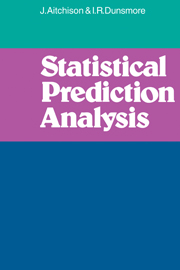Book contents
- Frontmatter
- Contents
- Preface
- 1 Introduction
- 2 Predictive distributions
- 3 Decisive prediction
- 4 Informative prediction
- 5 Mean coverage tolerance prediction
- 6 Guaranteed coverage tolerance prediction
- 7 Other approaches to prediction
- 8 Sampling inspection
- 9 Regulation and optimisation
- 10 Calibration
- 11 Diagnosis
- 12 Treatment allocation
- Appendix I
- Appendix II
- Bibliography
- Author index
- Subject index
- Example and problem index
8 - Sampling inspection
Published online by Cambridge University Press: 12 October 2009
- Frontmatter
- Contents
- Preface
- 1 Introduction
- 2 Predictive distributions
- 3 Decisive prediction
- 4 Informative prediction
- 5 Mean coverage tolerance prediction
- 6 Guaranteed coverage tolerance prediction
- 7 Other approaches to prediction
- 8 Sampling inspection
- 9 Regulation and optimisation
- 10 Calibration
- 11 Diagnosis
- 12 Treatment allocation
- Appendix I
- Appendix II
- Bibliography
- Author index
- Subject index
- Example and problem index
Summary
Introduction
The myriad of possible statistical sampling inspection procedures forces us to consider in detail only a very small selection in a book of this size. We would need a separate book to do justice to the huge variety of plans. In this chapter therefore we show how some standard plans come within the framework of decisive prediction, and how the framework can readily cope with less standard problems. The application of prediction theory to this area will provide some additional justification and motivation for some of these plans. We hope that those selected will be sufficient to indicate the direction of analysis to any reader with a specific problem.
We consider both fixed size sample and sequential sampling schemes. Wetherill (1966) and Wetherill and Campling (1966) also provide a decision theory approach to sampling inspection but do not consider predictive distributions.
Fixed-size single-sample destructive testing
We consider first a fixed-size single-sample plan for deciding whether to accept or reject a batch. For a process which produces an item at each of a number of independent operations we may imagine as our basic future experiment the determination of the quality y of a single item. This quality y may be a simple counting variable taking the value 1 for an effective and 0 for a defective item, or may be more sophisticated, for example the lifetime of a component or the degree of purity of a chemical preparation. We suppose that the probabilistic mechanism which describes the production of the variable y is a density function p(y|θ) on Y where, as in previous work, θ is an indexing parameter with density function p(θ).
Information
- Type
- Chapter
- Information
- Statistical Prediction Analysis , pp. 146 - 161Publisher: Cambridge University PressPrint publication year: 1975
